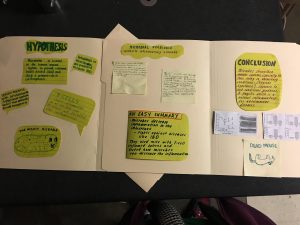In My Classroom: Reading Peer-Reviewed Papers
Welcome to the KABT blog segment, “In My Classroom”. This is a segment that will post about every two weeks from a different member. In 250 words or less, share one thing that you are currently doing in your classroom. That’s it.
The idea is that we all do cool stuff in our rooms and to some people there have been cool things so long that it feels like they are old news. However, there are new teachers that may be hearing things for the first time and veterans that benefit from reminders. So let’s share things, new and old alike. When you’re tagged you have two weeks to post the next entry. Your established staple of a lab or idea might be just what someone needs. So be brief, be timely and share it out! Here we go:
This year I am teaching a class that is new to me called “Honors Biology 2”. This course is split into Genetics the first semester and Microbiology the second semester. I was given a rough curriculum for the course and was encouraged to make it my own. Having only taught Freshman Biology last year (which was my first year teaching) I was a little nervous about how to challenge these students.
On the second day of school I asked my students to write down everything they could tell me about DNA. I not only got full molecular structures with phosphodiester bonds labeled, but some students drew full replication forks with all enzymes labeled. My next days’ lesson for reviewing DNA structure and replication was scrapped and I came to class the next day with 70 copies of Meselson and Stahl’s original publication.
My smarty-pants students said “they proved DNA replicates semi-conservatively”, to which I said “how did they prove that?”. Shocker, but they didn’t have a response.
So we started into it. I gave my students a CER form and asked them to explain the evidence provided in the paper for how DNA replicates. They ended up needing 3 full class periods to get through the paper and really understand it, and they complained all three of those days. After students understood something they would say “why didn’t they just say that in the paper” or “why did that have to be so difficult” which lead us into good conversations about the content as well as science in general.
Despite my students’ grumbles we have read 4 scientific, peer-reviewed papers this year. For our most recent one, titled “A microbial symbiosis factor prevents intestinal inflammatory disease” I had students create a mini-poster that describes the experiment. I’ve also had students summarize each paragraph of these papers into one sentence, re-do a diagram in the paper, use the thing explainer method to explain the paper, or draw a graphic novel explanation of the paper. We have gotten to the point where students don’t actively hate these papers and have started to see them as a cool way to gain new information.

An example of a mini-poster that explains the research. Note the diagrams taken from the paper and the dead mouse.
I’ve used these papers to introduce new ideas or elaborate concepts with recent research. The thing I’ve found most rewarding as a teacher is how confident my students feel once they are able to explain these difficult readings. They face a challenge, overcome it, and then feel really great about it. It has also forced them to “think like a scientist” if I ask them things like “why did they do it that way”. Several parents have said things like “I couldn’t even understand the title of that” or “my student came home and explained this to me”. I haven’t had my Freshman biology students read a full paper (yet), but have had them read abstracts or analyze some cool diagrams.
That’s all for me. Sorry for going way over my 250 word limit. Kelly Kluthe is next at her own request!
P.S. thanks to Eric Kessler’s how-to for helping me stop making excuses for posting!

